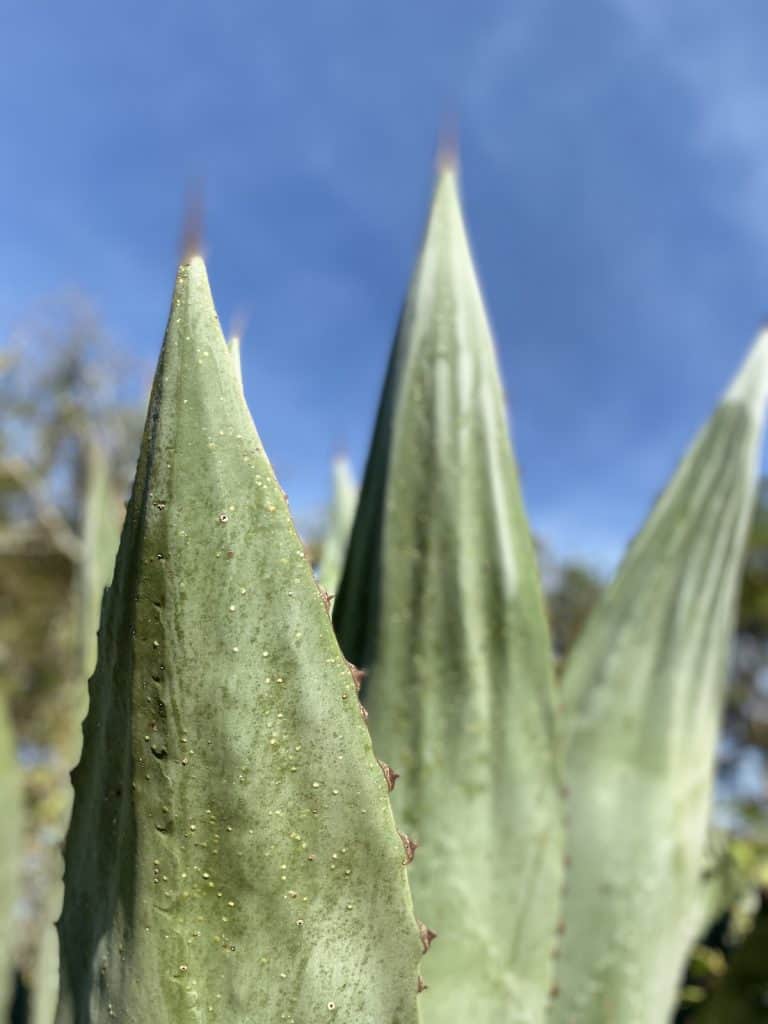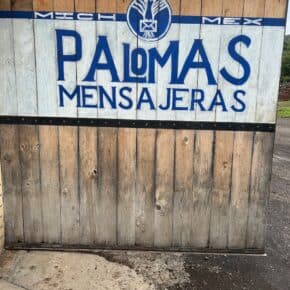
A couple weeks ago, I visited La Luna Mezcal’s vinata in Cotija, Michoacán with Salvador Chavez, the founder and CEO. We were just in time to catch an ensamble distilling with tejocote and guava, the smells of tropical fruit wandering through the air as the team filled the oven with piñas for their next batch. In the background, avocado orchards blanketed the ridge that separates Michocán from Jalisco’s raicilla territory. Around us there were cornfields, fruit trees, wild inaequidens, and Salvador’s earliest memories of mezcal.

Salvador’s father grew up at the house next to this vinata and as a teenager immigrated to Sonoma, where Salvador was born and raised. What pulled him back to Michoacán to start a mezcal brand are his early memories of visits here, watching his family sip on mezcal with the salty cheese endemic of this area. Salvador expanded his hospitality repertoire from owning and running family restaurants in Sonoma about three years ago when he started Puente International, importing Mexican spirits, including Gran Dovejo Tequila, La Luna Mezcal and Gustoso Aguardiente Rum, the latter two made in Michoacán. In many ways, La Luna is the mezcal story of our times— a return to the homeland by an immigrant son who is creating jobs, shining a light on an under appreciated region of Mexico, and making quality mezcal.


But La Luna is also a young company that’s made a lot of changes, and just now has figured out its identity and where it can most make an impact in the market and in Mexico. As those of us in the industry know, mezcal stories can be as romantic as they are complex.
—

It was 4 a.m. in Morelia when Adrian Gallegos, La Luna’s operations manager, picked me up to head to Cotija, and I came with pillow in hand ready to sleep in the car for the four hour drive. But Adrian is like that cool college professor who somehow distracts from your pounding hungover skull in an early morning class with a good story told in language we can all relate to.
“Por eso dicen a ese guey que es bruto, es bruto el cabron, si te descuidas o si no estás acostumbrado, se te puede hacer que no te aguantas de cómo te va a picar,” he said explaining the nickname for the agave Inaequidens. They call that dude Bruto, so fucking rough on the skin it’s a beast to work with. By sunrise I had the company and family history down, along with a complete 101 on Michoacán agaves.

It makes sense that Adrian has his own spin on the agave lecture, because his path to mezcal is unique. In late 2015, Salvador and Adrian hit it off immediately when Adrian picked up Salvador as an uber driver in his native Guadalajara, and Salvador hired him as his driver for the rest of his trip. Soon Adrian was helping with other jobs related to the business, and in 2017 when Salvador decided he needed someone on the ground full-time in Michoacán, Adrian moved to Morelia. He’s the kind of smart that can pick up anything quickly, evidenced in his ever-expanding role of managing the staff, making decisions with mezcaleros, overseeing quality control, and building out the new vinatas— the blueprints of this growing brand’s future.
La Luna entered the market a few years ago with a single expression, a cupreata hovering at about 47 ABV. While it received a lukewarm welcome from mezcal aficionados, it stumbled into a market niche: the cocktail mezcal. According to Salvador, the “black label” was initially attractive to accounts like Bavel in LA and the Ace Hotel in Chicago, for its accessible price and a flavor profile that stood out against the Oaxacan espadins in the cocktail placement. “For the longest time it wasn’t intended to be a cocktail mezcal, but what the market dictated to us was that the black label kicked ass in the cocktail placement, although it didn’t fulfill the want of a geekier palate,” said Salvador. Last year, the brand took greater shape as La Luna introduced new expressions in addition to the black label, which has secured its place as one of the best cocktail mezcals. In the new expressions— a cupreata, tequilana and manso sahuayo—you’ll now find flavors that represent the biodiversity and the talented mezcaleros of Michoacán. In the next few years they’ll be expanding their roster of expressions, adding more ensambles and ancestral mezcals.

That evolution represents a shift in the way La Luna does its production. After experiencing issues with quality control and delays, they pivoted from buying mezcal from one mezcalero toward becoming a producer, i.e. building their own vinatas in Indaparapeo, Cotija and Etucuaro with their own teams that sometimes travel between these vinatas to solely produce La Luna. Mezcal is now produced in these different vinatas, with each of the teams operating differently with different ownership structures, and working with agaves which are sourced from different places based on proximity. Salvador travels down at least twice a month, and Adrian zigzags across the state daily.



All of the mezcaleros are members of the Scott and Perez families, who have been making mezcal in Michoacán for several generations. The older guard of the family is on board, but it’s the younger cousins in their 20s who La Luna works with closely and who now form a team of mezcaleros who will grow with the company. That progression captures an aspect of La Luna’s unwritten company culture that’s about creating jobs and retaining a team, a value carried over from Salvador’s restaurant experience. This is especially important in rural areas of Michoacán, where young people have few options. One of the mezcaleros until recently used to go to North Carolina every year for work. In Cotija I met two workers Adrian said no one else would hire because of their past drug use. At Indaparapeo where they’re building a bigger vinata, they already have a small staff of of women who have moved up the ranks, their first mezcalera apprentice being one of them. They’re paying higher than market rate specifically to keep a team for the long haul.



—
There are a few geographical locations that offer a glimpse into where La Luna has come from and how we’ll see them grow their roots.
La Luna works with two vinatas in Etucuaro, which is where their first expression comes from. “The irony is that our newest expressions are by far the most appreciated and special, but the cocktail mezcal is what keeps us busy every day,” said Salvador.
Etucuaro is the hub of mezcal production in Michoacán, where the merging of two climates is perfect territory for cupreatas to flourish. This cupreata is produced in a traditional method passed down by the Perez family and retails at $35 a bottle by employing two strategies. First they save on time, shortening cooking by one day, not resting agave after cooking which is typically done with the other expressions, and fermentation is about three days quicker because they add a higher ratio of water to the fermentation. After that, a cut of the first distillation mezcal is added to a second-distilled product, technically passing through the CRM’s certifiers because it counts overall as a double distillation.
This might be controversial, but while the rest of the mezcal world grapples with the ethics of the cocktail mezcal, La Luna has quietly emerged with an interesting product offer that’s steadily making its way into wells across the country. “We know that cocktailing is this global movement, and it’s putting undue pressure on a category that is making it irresponsible and unethical, but it’s an issue that we can solve for and create a positive human impact,” said Salvador.

As La Luna works to expand their brand awareness and sales territory, they’ll be meeting potential demand at their vinata in Indaparapeo, a town less than an hour away from Morelia. They currently rent a vinata there, typically working with cupreata and tequilana. Across the fields of tequilana however, they’re slowly building out a new vinata that’ll hold three stills per oven, potentially working towards a total of ten ovens, 100 fermentation vats, 15 Filipino stills, and five ancestral stills. Right now they’re a production staff of about six in Indaparapeo, and anticipating a jump to about 20 this year, while keeping production in Etucuaro as well. “The carrot for us to grow our sales is really to make a stronger human impact,” said Salvador. As for agaves, they’ve been prepping for this jump for a while and planning with different family farms— and, as an example, have 400 tons of cupreata committed for next year from one family.

Back in Cotija, they’ll be able to distill small batches of ancestral mezcal, representative of the clay still traditions of neighboring Jalisco. This is La Luna’s newest vinata and still awaiting certification. Constructing a vinata on Salvador’s family’s land at first glance seemed more sentimental than practical— until they grow a team the mezcaleros have to travel several hours to get here. But for a company with a web of production sites and a lot of transitions in a short lifespan, Cotija is an anchor. Salvador’s family is in the area making mezcal and cheese, and his uncle and aunt still live here and can oversee the vinata. Cotija is where they designed a vinata from scratch, it’s where they can experiment, and it’s what will continue to make La Luna stand out in the market. In Cotija, La Luna’s roots grow deeper and their story comes full circle.












Great article and photos! I will be on the lookout for La Luna. Muchas Gracias!